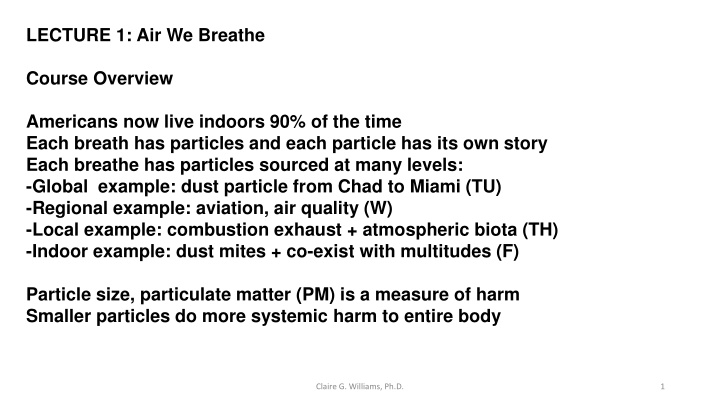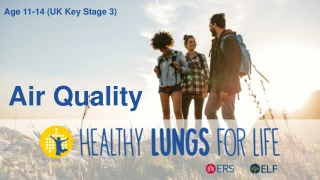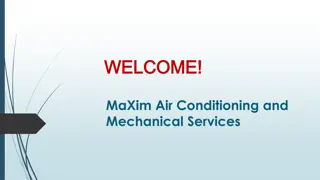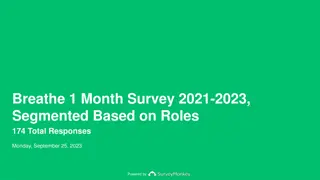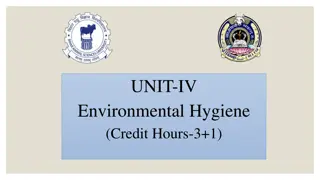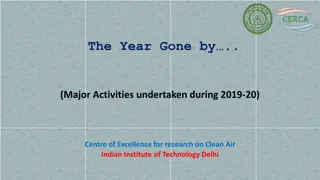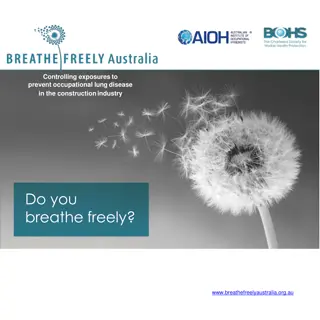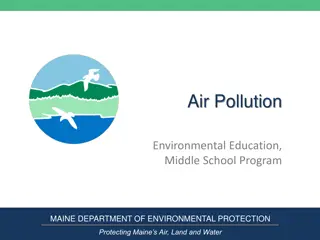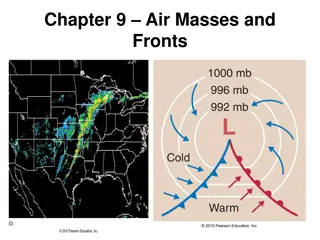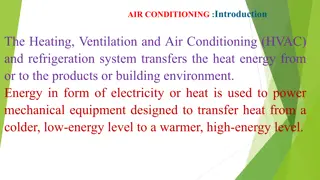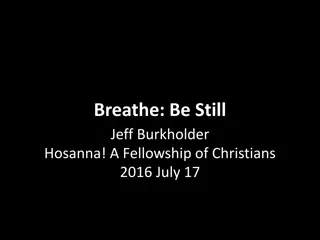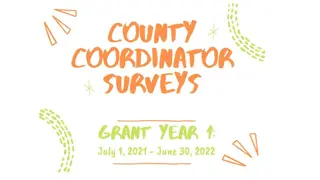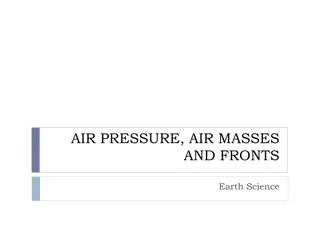LECTURE 1: Air We Breathe Course Overview
Americans predominantly spend 90% of their time indoors, where each breath taken contains particles sourced from various levels - global, regional, local, and indoor sources. These particles, known as particulate matter (PM), can have differing effects on the body based on their size, with smaller particles causing more widespread harm. Understanding the composition and impact of these particles is crucial for maintaining healthy indoor and outdoor environments.
Download Presentation

Please find below an Image/Link to download the presentation.
The content on the website is provided AS IS for your information and personal use only. It may not be sold, licensed, or shared on other websites without obtaining consent from the author.If you encounter any issues during the download, it is possible that the publisher has removed the file from their server.
You are allowed to download the files provided on this website for personal or commercial use, subject to the condition that they are used lawfully. All files are the property of their respective owners.
The content on the website is provided AS IS for your information and personal use only. It may not be sold, licensed, or shared on other websites without obtaining consent from the author.
E N D
Presentation Transcript
LECTURE 1: Air We Breathe Course Overview Americans now live indoors 90% of the time Each breath has particles and each particle has its own story Each breathe has particles sourced at many levels: -Global example: dust particle from Chad to Miami (TU) -Regional example: aviation, air quality (W) -Local example: combustion exhaust + atmospheric biota (TH) -Indoor example: dust mites + co-exist with multitudes (F) Particle size, particulate matter (PM) is a measure of harm Smaller particles do more systemic harm to entire body Claire G. Williams, Ph.D. 1
LECTURE 1: Air We Breathe Science literacy (science appreciation) is our lens on air we breathe Air, its particles and each particle s history and origins. Science literacy includes methods, narrative & experiential accounts Point 1: Science fiction inspires complex research experiments Atmosphaera Incognita by Neal Stephenson Point 2: Science as one way of knowing Point 3: Relationship of science to society is dynamic Point 4: Rise of fake science is eroding societal trust 2/3/2024 Claire Williams OLLI 2024 2
Point 1: Science fiction inspires complex research goals Atmosphaera Incognita by Neal Stephenson Class Question: What do you want to know about this tower s ascending altitudes from 0 to 20 km? 2/3/2024 Claire Williams OLLI 2024 3
Excerpt from Atmosphaera Incognita science fiction story by Neal Stephenson 2/3/2024 Claire Williams OLLI 2024 4
LECTURE 1: Air We Breathe Point 1: Science fiction inspires What are our class questions? 2/3/2024 Claire Williams OLLI 2024 5
LECTURE 1: Air We Breathe Science literacy Point 2: Science as one way of knowing. Chapter 14 Sapiens Y.N. Harari Scientific method is a system for gaining authenticated knowledge Q: What is authenticated knowledge and now is it built? A: Paraphrased from Kevin Kelly The Technium Science is the organization of knowledge [so] that a) Knowledge can be tested b)New varieties of knowledge can appear c) It can be archived and restored d)It can be communicated without grave error e) It can be built upon and extended, and most importantly Science is the method whereby knowledge is structured so that it can be structured further. 2/3/2024 Claire Williams OLLI 2024 6
LECTURE 1: Air We Breathe Science literacy Google and other Internet browsers Point 2: Science as one way of knowing. Authenticated knowledge + its hierarchy is not apparent from Internet browsing Secondary Authenticated knowledge has a structure + ranking Primary sources are preferred Source: http://courses.eurlib.nl/course.cfm?course= Scholarly+publishing&page=The+literature+pyramid 2/3/2024 Claire Williams OLLI 2024
LECTURE 1: Air We Breathe Point 3: Relationship of science to a society is dynamic Scientists as heroes Sputnik in 1957 U.S. Race to the Moon Cancer cure Scientists as doomsday sayers Covid19 in 2020 Climate change Other ways of knowing, not science, can take precedence in policy & politics 2/3/2024 Claire Williams OLLI 2024 8
LECTURE 1: Air We Breathe Point 4: Rise of fake science is eroding societal trust (Beall 2016) Appetite for fake science, embedded inside public policy + politics 2/3/2024 Claire Williams OLLI 2024 9
LECTURE 1: Air We Breathe Point 4: Internet s appetite for fake science fuels public policy + politics Criteria Scientific research vs. Science Policy Timeline Scientific is lengthy, incremental Short perpetual urgency Cognitive Demands Depth, detail, little range Range huge, little or no depth Process Understand, explain Make decisions, act Problems to be solved Issues to be resolved Currency Knowledge, content, expert Power, influence, process Deliverables Lengthy knowledge acquisition Absolute deadlines Ready only when good enough Incentives Innovation, publishing, funding Orchestrating favorable outcomes Means Individualist action, autonomy Team playing, no enemies In Memoriam: Stephen D. Nelson (1943-2014) AAAS Sr Policy Advisor 2/3/2024 Claire Williams OLLI 2024 10
Dear Dr. Claire G Williams, Austin Environmental Sciences (ISSN: 2573-3605), Impact factor 1.9 , aims to publish high quality papers, Alternative and Integrative medical research. Journal is organizing a special issue on Air Pollution . This journal facilitates the research and wishes to publish papers as long as they are technically correct, scientifically motivated. The journal also encourages the submission of useful reports of research results. Journal covers all areas of clinical & medical sciences and publishes case reports, case series, clinical images and presentations. This is a quality controlled, OPEN peer reviewed, open access INTERNATIONAL journal. Article Published: (18-25 days). Kindly send your article in MS word format. With Regards, Rebecca Williams Editorial Office- Austin Environmental Sciences Austin Publications LLC 6565 N MacArthur Blvd Ste 225, Irving Tx 75039, USA, Call: +1-201-655-7075. 2/3/2024 Claire Williams OLLI 2024 11
Predatory journals, conferences, books Example Monday February 5 2024 Dear Dr. Williams CG, I hope this message finds you well. I'm honored to invite you to speak at 3rd Global Conclave on Advanced Cardiology and Cardiovascular Innovations (Adv. Cardiology 2024) held during June 27-28, 2024 at Amsterdam, Netherlands. We would be delighted to have you present as a Distinguished Speaker at this conference to give an oral presentation on your publication titled "Changing particle content of the modern desert dust storm: a climate? ?health problem.". We'd love to hear your thoughts and opinions on this study, or you can also choose any other paper from your research that is relevant to Adv. Cardiology 2024. Kindly let me know your interest for participating at the conference so that I will send you further details. For more details, Click Here: Cardiology Conferences Look forward to receive your positive response. Attention...: with sponsorship? Please reach out to us by email. Warmest Regards, Shena Hodiah Program Director Peers Alley Media 1126 59 Ave East, V5X 1Y9 Vancouver BC, Canada Interested in attending this event 2/3/2024 Claire Williams OLLI 2024 12
LECTURE 1: Air We Breathe Overview Each breathe is air and particles which originate far and near -global -regional local -indoor Each particle has its own trail - or trajectory Trajectory: sourced or emitted, entrainment, transport and deposition -particle load is a shared global commons -transport horizontal and vertical -transport linked to atmosphere s motion, layering and gradients -studying particles in a breathe is a multidisciplinary project -tracing articles varies in time and space, scales 15 orders of magnitude 2/3/2024 Claire Williams OLLI 2024 13
The Air We Breathe 2/3/2024 Claire Williams OLLI 2024 14
2/3/2024 Claire Williams OLLI 2024 15
Class focus: Stratosphere Troposphere 2/3/2024 Claire Williams OLLI 2024 16
Atmospheric Layers Tropopause 11.3 km -12 C @ 5 km Inversion 2.9 km Planetary Boundary Layer (PBL) 1.9 km 2/3/2024 Claire Williams OLLI 2024 17
2/3/2024 Claire Williams OLLI 2024 18
